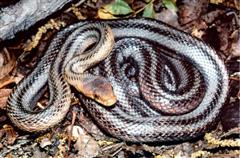Rat Snake - Baird's
Baird's Ratsnake, Bairds Ratsnake Scientific Name: Elaphe bairdi
Fri, 25th April, 2025 - 8:40 pm GMT
Sponsor Ads:

Alternative Name
Baird's Ratsnake, Bairds Ratsnake Scientific Name: Elaphe bairdiBasic Info
By maturity, most Baird's Rat Snakes reach lengths between 25 and 55 inches . The scales are slightly keeled. Usually the dorsal color is gray and brown, although it may be available in both amelanistic and leucistic varieties. The edges of the scales are usually decorated with yellowish or orange coloring on the front of the snake's body. The scales toward the rear of the Baird's Rat Snake are usually edged in darker salmon or orange shades. The underside of the snake is usually lighter, ranging in shade from pale gray to yellow. However, as the scales approach the tail, they darken to a salmon color.
Health
Baird's Rat Snakes will often do well in 20 to 30 gallon terrariums. If using a 20-gallon, it should be a 20 long (24 x 12 x 12 inches) so that there is adequate floor space to provide a temperature gradient across the cage as well as accommodate the snake and its cage accessories. Many people prefer to use larger terrariums with more height, as these rat snakes will often utilize branches for climbing, making a nice display. Daytime temperatures should fall between 80 and 85 degrees Fahrenheit with a basking spot about 90 degrees. At night the temperature should be about 75 degrees. Dryer conditions are preferred. A hide box and a simple substrate like newspaper or plastic grass should be provided. Baird's Rat Snakes are usually quite hardy when properly set up and maintained. Breeding Baird's Rat Snakes usually breed in the beginning of the summer. Although many people hibernate Baird's Rat Snakes before breeding, full cooling is usually not necessary. Often a small drop in temperature can suffice. Often, a clutch of six to eight eggs is deposited after a successful mating. However, up to 15 eggs are possible and in the wild, ten are average. When incubated at 27 degrees Celsius, the clutch will usually hatch in 60 to 80 days. In the wild, eggs usually require about 84 days. Hatchling Baird's Rat Snakes will usually eat pinkie mice after their first shed or as early as a few days after hatching. They are about 12 inches long and have banded markings of gray or brown.Habitat
Found in more arid scrublands or wooded, rocky areasBehavior
Baird's Rat Snake is often valued for its relatively docile nature and its lovely coloration. These animals can make good pets for keepers with little or lots of experience. In the wild, Baird's Rat Snake is often found in more arid scrublands or wooded, rocky areas. Although generally peaceful, it will hiss if it feels threatened and may strike in self - defense if it continues to be harassed. Wild caught Baird's Rat Snakes may require more time to become accustomed to handling than captive bred specimens. Often these snakes may release musk or may attempt to strike when initially held captive, though they often calm with patience on the part of the handler. Usually, captive-bred snakes are available, since this species tends to breed successfully in captivity.Origin
Southwest United StatesHistory
Baird's Rat Snake is native to southern North America. They are found in Texas in the United States and range down into northern Mexico.Common Foods
Baird's Rat Snakes feed on small mammals, small reptiles, and birds.Sponsor Ads:
Celibacy is not hereditary. -- Unknown
Rat Snake - Baird's
Coded by: BGID® | ALL RIGHTS RESERVED Copyright © 2000-2025
Disclaimer | Privacy | Report Errors / Contact | Credits








 President of the United States of America - Real Estate mogul, Pageant owner and now one of the most controversial men in political history.
President of the United States of America - Real Estate mogul, Pageant owner and now one of the most controversial men in political history.  Politician, US Vice President and President of the USA - Joseph Robinette Biden Jr.
Politician, US Vice President and President of the USA - Joseph Robinette Biden Jr.  versus
versus  Russia: 'The Evil Empire'? Are they all that bad or is it just the USA trying to portray Russia as bad because they are a world power with land bigger and a society very different from the USA ideal?
Russia: 'The Evil Empire'? Are they all that bad or is it just the USA trying to portray Russia as bad because they are a world power with land bigger and a society very different from the USA ideal?  Global warming has been in and out as the "latest" hot topic for many years. It is, according to modern scientists, the result of man-made industrial pollutants, clearing forested areas, agriculture, etc. But now they are thinking it started way before the Industrial Revolution...
Global warming has been in and out as the "latest" hot topic for many years. It is, according to modern scientists, the result of man-made industrial pollutants, clearing forested areas, agriculture, etc. But now they are thinking it started way before the Industrial Revolution... 
 Corona virus
Corona virus 
 Users with wide screen monitors can benefit from more content on every page.
Users with wide screen monitors can benefit from more content on every page.